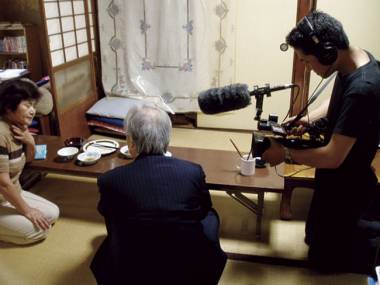
March 20, 2009
Head Case
In his new documentary, director Kazuhiro Soda explores the taboo subject of mental illness
By Metropolis
Originally published on metropolis.co.jp on March 2009

Widely regarded as one of Japan’s leading new documentary filmmakers, Kazuhiro Soda made a name for himself with his first full-length movie, Campaign. Released in 2007, the film depicted the adventures of an unlikely LDP candidate in his quest to win a city council seat in Kawasaki. While Soda’s shadowing of his subject with a handheld camera may not have created a flattering advertisement for the LDP, it did produce a triumph for the cinéma vérité style of filmmaking: it debuted at the Berlin International Film Festival, enjoyed a weeklong run at New York’s Museum of Modern Art, and was broadcast on TV in 20 countries.
In his latest offering, Mental (“Seishin”), Soda uses the same fly-on-the-wall filmmaking techniques to record life inside a small mental health clinic in Okayama Prefecture. Due for domestic release in June after generating a buzz on the international film-festival circuit, Mental takes audiences into a world that many would prefer to keep hidden. Soda depicts consultations and therapy sessions, with interviews that delve into the patients’ personal histories and battles with mental illness. The result is a film that offers not just greater insight into the world inside the clinic, but into Japanese society as a whole.
From his home in New York City, where he has lived since 1993, Soda reveals that Mental’s subject matter was, in part, determined by his own experiences as an editor of Tokyo University’s student paper.
“It’s only a student newspaper, but it has a long history that goes back to the Taisho era,” explains the 38-year-old Tochigi native. “I had to organize the finances as well as the editing, and we had to publish every week, so I was working day and night. One day I woke up and found myself unable to do anything. When I went to the computer, I couldn’t write.”
Soda sought help at Todai’s department of psychiatry, where he received a diagnosis of “burn-out.” He received medication, quit the newspaper and, after catching up on weeks of lost sleep, managed to recover. The experience, however, made him reconsider his ideas about mental illness.
“I thought I was immune to that sort of thing, but I wasn’t. It changed my view of mentally ill people too. We have this demonic image of them, that they are scary. But for a time, a very brief period, I was one of them, and I wasn’t a monster. So I was always interested in this subject.”
This director’s experience is far from unique. A study last year by the Ministry of Health, Welfare and Labor found that 24 percent of Japanese people had suffered from some kind of mental health problem. Another report found that one in five adults had considered killing themselves, with actual suicide rates at 23.7 per 100,000 people—twice as high as the USA and three times that of the UK. The figures have prompted a $222 million government campaign to raise awareness of the issue and to make counseling services more widely available.
Despite these numbers, mental health treatment in Japan is widely regarded as lagging behind that of many other developed countries. Until as recently as 1987, patients with more severe emotional problems could be institutionalized against their will under the “Mental Hygiene Law.” Even today, a sense of shame prevents those who suffer less severe ailments from seeking treatment. Yuzo Kato, director of the Tokyo Suicide Prevention Centre, is critical of the government campaign to reduce the suicide rate, which focuses mainly on making counseling services available. “More should be done to end the cultural stigma attached to mental illness,” he says.
Mental was filmed at Chorale Okayama, an outpatient clinic run by Dr. Masatomo Yamamoto, who for decades has been involved in changing attitudes towards the treatment of the mentally ill in Japan. Yamamoto accords his patients a high degree of respect, listening to their opinions and involving them in decisions about treatment. The clinic features a patient-run restaurant and milk delivery service to help connect them with the outside world.
“[Masatomo’s] whole approach is related to an experience he had working in a large mental institution in 1969,” says Soda. “He wondered why the doors of the rooms and wards were locked, so he decided to have a discussion involving staff and patients. The discussion was about who was responsible for locking the doors of the rooms. The patients said it was the nurses, but the nurses said this was because the patients behaved badly—sometimes they would disappear or leave without permission.”
The dialogue between the two groups eventually led to greater understanding.
“The patients started to say, ‘Well maybe we should behave a little better,’ and the nurses started to say, ‘Maybe we’re locking the doors for the sake of our convenience.’ They began to work towards the same thing—having the doors unlocked. And I believe the most important thing was that the patients were included in this discussion. I don’t think many other mental institutions are like the one I filmed. Some are still like the one the doctor worked at in the ’60s.”
In the press material for Mental, Soda talks about an invisible “curtain” that hides this world of the mentally ill from that of so-called “normal” society.
“My job as a filmmaker was to open this curtain and create a film where the viewer has a kind of virtual experience of being in this mental clinic,” he explains. “By doing this, maybe you get some kind of respect, understanding or insights into the issue. It’s up to each viewer what kind of experience they get, but I hope it will be a positive and insightful one.”







